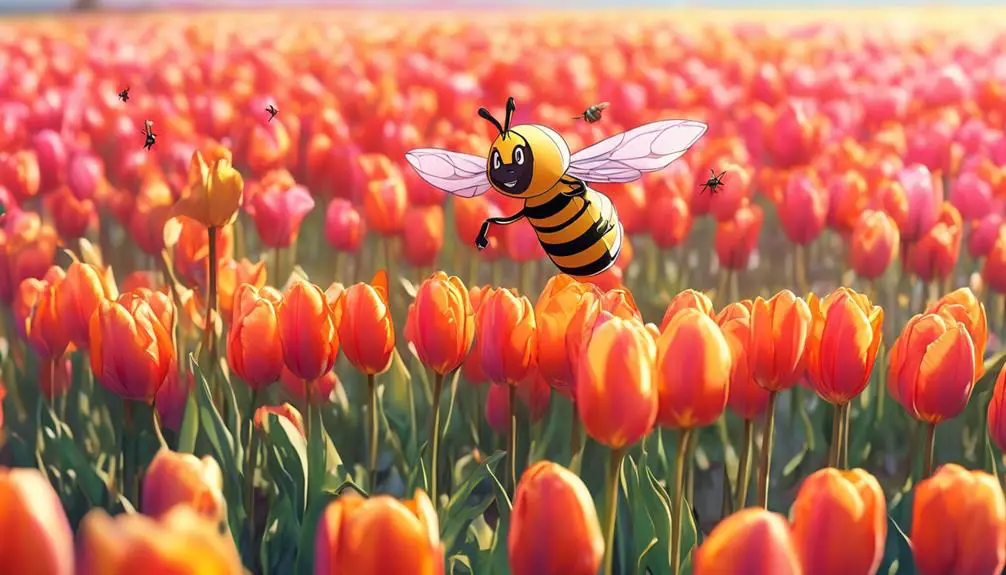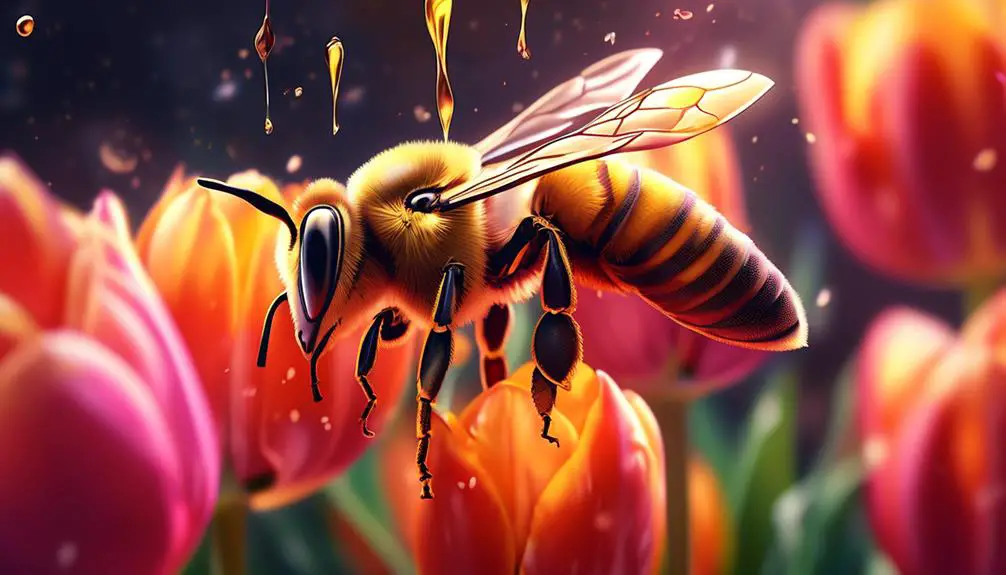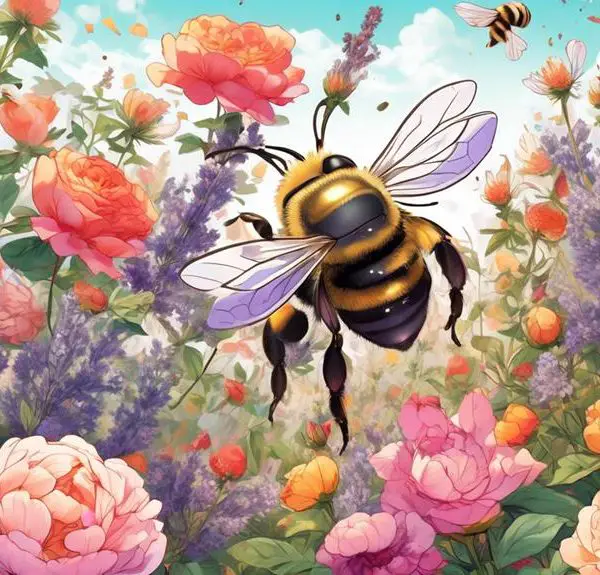Get ready to delve into the vibrant world of bees and tulips, where color, scent, and nutrition dictate the pollination dance.

Do Bees Like Tulips?
Have you ever wondered if bees have a preference when it comes to flowers, specifically tulips? You're about to embark on a fascinating journey into the world of bees and their interaction with tulips.
It's a realm where color, scent, and nutritional value play crucial roles in the pollination cycle. Just imagine, there's so much more to your garden's buzzing visitors and vibrant tulips than meets the eye.
Ready to uncover these intriguing details that could change how you view your garden?
Key Takeaways
- Bees are attracted to the bright colors and intoxicating scent of tulips.
- Bees perceive ultraviolet and blue as the brightest colors, making them most attractive.
- Tulips provide essential nourishment for bees through their nectar and pollen.
- Bees play a crucial role in tulip pollination, promoting plant biodiversity and resilient populations.
Understanding Bee Attraction

To understand why bees might be attracted to tulips, it's crucial to delve into the complex relationship between these insects and flowers, including the mechanisms of pollination and the role of color and scent in attracting bees.
Bees are enticed by bright colors, with red, yellow, and orange being particularly attractive. Tulips, coming in a variety of vibrant hues, often serve as a visual beacon for these tiny pollinators.
But it's not only the color that draws them in. The aroma of a flower, often undetectable to humans, can be an irresistible lure for bees. Tulips emit a scent, which when combined with their bright colors, makes them a magnet for bees.
Add to this the nectar that tulips produce, a sweet liquid that provides essential nourishment for bees. By dipping into the heart of the tulip, bees get a meal and, in return, help with pollination. It's a symbiotic relationship that has evolved over millions of years.
Color Preferences of Bees

While we've seen how tulips' vibrant colors and enticing scent attract bees, it's worth exploring in more detail the specific color preferences of these industrious insects. Research shows that bees don't see color the same way we do. Instead, they see in a spectrum ranging from ultraviolet to orange, with an incapacity for detecting red.
Let's delve into the colors that bees are particularly drawn to.
Color | Wavelength Range (nm) | Bee's Perception |
|---|---|---|
UV | 300-400 | Bright |
Blue | 400-500 | Very Bright |
Yellow | 570-590 | Less Bright |
As you can see, bees perceive ultraviolet and blue as the brightest colors, making these the most attractive to them. While they can see green and yellow, they perceive these as less bright. Red, despite being vibrant to us, is seen as black by bees and hence, less appealing. This has significant implications for the colors of flowers, like tulips, that bees are likely to pollinate. Understanding bees' color preferences can aid in creating bee-friendly gardens, ensuring these vital pollinators continue to thrive.
The Role of Scent in Attraction

Beyond their vibrant hues, bees are equally drawn to the intoxicating scents emitted by flowers like tulips, playing a crucial role in their attraction. Bees have an acute sense of smell, facilitated by their antennae which function as olfactory organs. They're able to detect and differentiate between a range of scents, making them proficient pollinators.
When you dig deeper into the world of bees, you'll discover that the scent of a flower is a complex cocktail of chemicals, each with its own potential to attract or repel bees. Tulips, in particular, emit volatile organic compounds (VOCs) that bees find irresistible. These VOCs serve as a kind of olfactory billboard, advertising the flower's nectar and pollen to passing bees.
Moreover, the scent of a flower can change throughout the day, and even throughout its blooming cycle. This dynamic nature of scent serves as a signal to bees, telling them when the flower is most ripe for pollination.
In essence, the scent of tulips and other flowers is more than just a pleasant aroma; it's a sophisticated communication system that plays a vital role in the survival of both the bees and the flowers they pollinate.
Nutritional Value of Tulips for Bees

Having explored the olfactory allure of tulips for bees, let's now consider the nutritional benefits these flowers offer our buzzing friends. Tulips, like most flowering plants, produce nectar and pollen, two essential food sources for bees.
Nectar, a sugary liquid, provides bees with energy. It's comprised primarily of natural sugars, including fructose, glucose, and sucrose. Tulips, known for their relatively high nectar production, serve as a significant energy source for bees during the spring bloom period.
On the other hand, pollen provides bees with proteins and fats. This granular substance is crucial for the development of bee larvae. Tulip pollen is particularly rich in proteins, promoting healthy growth and development in bee colonies.
It's also worth noting that tulips contain a myriad of micronutrients, such as amino acids, vitamins, and minerals. These nutrients help maintain the bee's health by supporting various physiological functions, including digestion, immunity, and reproduction.
In essence, tulips present a nutritionally rich banquet for bees. They offer not just a feast for the senses but also a well-rounded meal, fulfilling a bee's dietary needs. So, while bees may be initially drawn to tulips by their scent, it's the nutritional value that keeps them coming back.
Impact on Bee-Tulip Pollination Cycle

Let's dive into the impact bees have on the pollination cycle of tulips, a key process that influences the survival and propagation of these vibrant flowers. Bees are crucial for tulip pollination as they transfer pollen from the male anther to the female stigma, enabling fertilization.
As a bee lands on a tulip, it's typically searching for nectar. While it's there, pollen grains attach to its hairy body. When the bee visits another tulip, some of these grains rub off onto the stigma, initiating cross-pollination. This exchange of genetic material promotes plant biodiversity and results in stronger, more resilient tulip populations.
However, it's not a one-sided relationship. Tulips, in turn, provide bees with necessary nutrients during early spring when food sources are scarce. This mutualism strengthens both the tulip and bee populations, enhancing ecosystem stability.
But remember, this delicate balance is easily disrupted. Pesticides, habitat loss, and climate change can negatively impact bee populations, consequently affecting tulip pollination. So, it's essential to recognize the interconnectedness of nature and work towards its preservation.
After all, a decline in bee numbers isn't just bad news for tulips; it's a warning signal for biodiversity as a whole.
Frequently Asked Questions
What Are the Common Types of Bees That Are Attracted to Tulips?"
You're likely to see several types of bees buzzing around tulips.
Honeybees are commonly attracted to these flowers, as they're drawn to their bright colors and sweet nectar.
Bumblebees are another variety that enjoy tulips, as they can easily access the nectar with their long tongues.
Lastly, solitary bees, like mason bees and mining bees, often visit tulips.
It's a wonderful sight when you're gardening and you spot these busy pollinators at work!
Can Planting Tulips in My Garden Have Any Negative Effects on Bees?"
Planting tulips in your garden won't have negative effects on bees. In fact, it's quite the opposite. Tulips, especially those with exposed centers, provide early spring pollen, which is vital for bees' nutrition.
However, you should avoid using pesticides on your tulips as they can harm bees.
Does the Climate or Season Affect a Bee's Attraction to Tulips?"
Yes, climate and season do affect a bee's attraction to tulips.
Bees are more active in warmer weather and tulips bloom in the spring, which is prime time for bees.
In colder temperatures, bees aren't as active and tulips aren't in bloom.
What Other Flowers, Besides Tulips, Are Bees Typically Attracted To?"
You're curious about the variety of flowers bees are drawn to, aren't you?
Well, aside from tulips, bees typically love flowers such as sunflowers, lavender, and daisies. They're also big fans of bluebells, foxgloves, and snapdragons.
These plants provide ample nectar and pollen, attracting bees with their vibrant colors and strong scents.
How Does the Presence of Bees Affect the Growth and Health of Tulips?"
Yes, bees are crucial for the health and growth of tulips. They play a vital role in pollination, transferring pollen from the male parts of a flower to the female parts. This fertilization process stimulates the growth of seeds and fruit.
Without bees, your tulips wouldn't reproduce as efficiently. So, while you're admiring those beautiful blooms, remember it's the hardworking bees that are partly responsible for your garden's thriving tulip display.
Conclusion
So, do bees like tulips?
Absolutely! Your garden's tulips are a bee magnet, thanks to their vibrant colors and irresistible scents. These features help bees spot them from afar.
Not only are tulips a feast for their eyes, but they also provide essential nutrients for bees. This relationship aids in the crucial pollination cycle, ensuring the continual blooming of your tulips.
So, plant more tulips, and watch your garden buzz with life!



